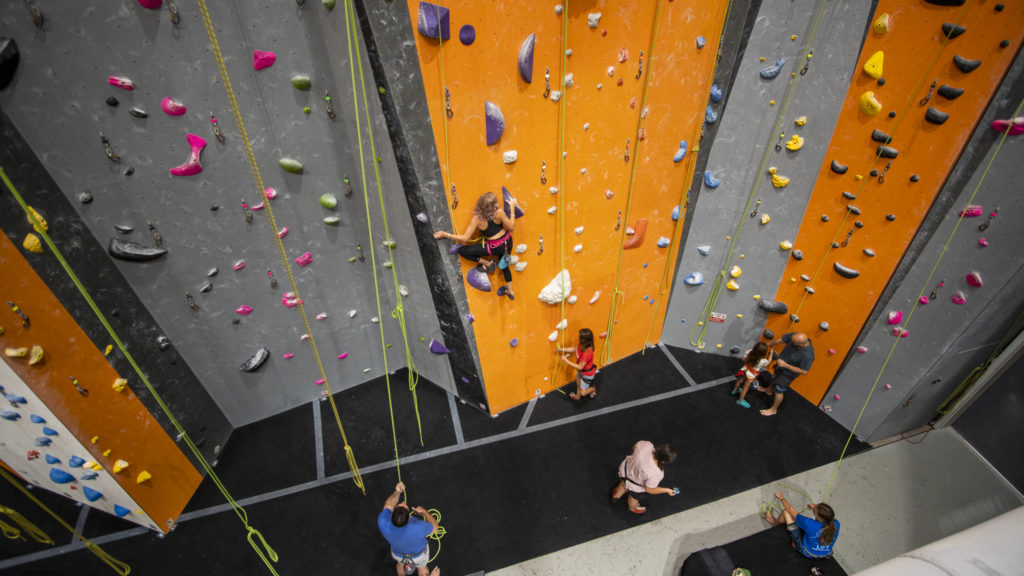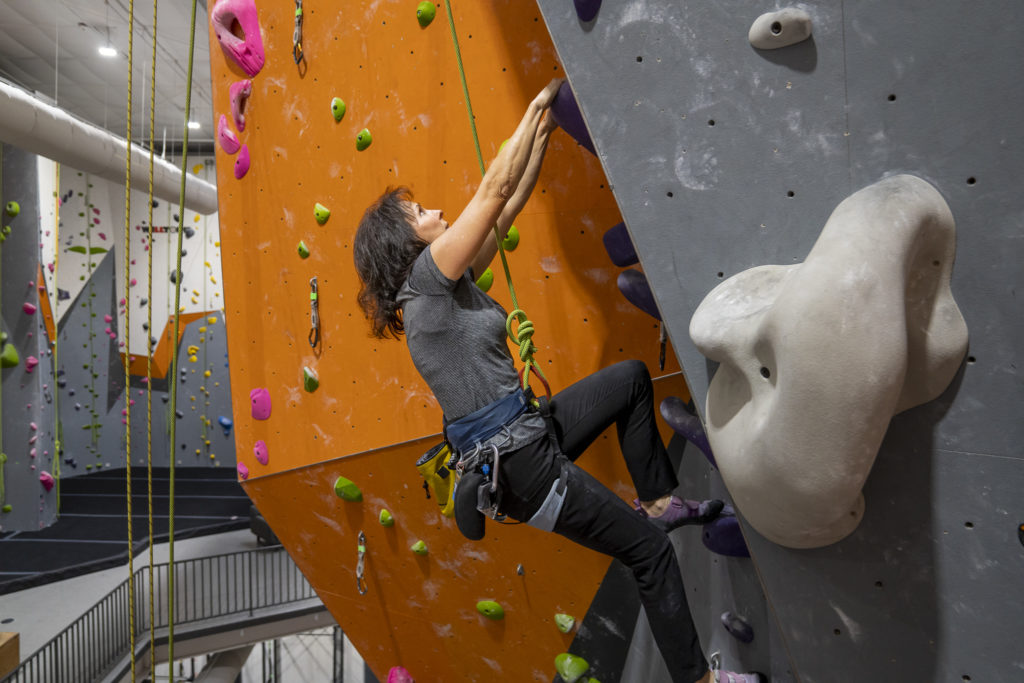Top Rope Climbing
You may be a brand-new climber or even a boulderer, ready to see all the rope fuss. Whatever your climbing background, top rope climbing is a fantastic and exciting skill to learn. Additionally, it can be a great space to meet fellow climbers and get more comfortable in a climbing gym environment as a new climber.

“Top rope” or “top roping” is the climbing one might picture when first considering gym climbing. The top rope involves two people, a climber and a belayer, both wearing harnesses. A rope feeds through an anchor system at the top of a climbing wall, with the ends running back toward the ground. The climber “ties in” or attaches one end of the rope to their harness using a knot, most commonly the figure-eight or trace-eight knot. Towards the other end of the rope, the belayer will attach themself to the rope using a belay device. The system is closed once both partners are correctly secured, and climbing can begin.
Risks of Top Roping
While there is always an inherent risk in climbing, when done correctly, top roping allows a climber to be caught when a fall occurs. This factor makes top rope a less dangerous variety of climbing. It adds a feeling of security that is helpful for climbers who are still getting used to the climbing challenges or are nervous about the exposure to height with no catch. Being tied in also allows for breaks without restarting an entire climb. Yes, you can spend some time dangling in the air if that’s your idea of a chill afternoon hang!
Top Rope Grades and Difficulty
Top rope routes are typically marked by colored holds (the “rocks” you grab while climbing) and are rated based on difficulty. The typical rating system is called the Yosemite Decimal System (YDS). It is a numerical scale starting around 5.2 and ending around 5.14 (that’s crazy hard). The first number refers to the type of terrain one is traversing. In a climbing gym, it will always be a “5” because it is so steep that you must use a rope to minimize risk. You may see a challenging hike with a “3” or a dangerous rock scramble with a “4.” The second number refers to the difficulty of the climb. The lower the second number is, the more beginner friendly, but remember that every climber is different, and the difficulty of ratings may vary from person to person. Top rope routes are also usually longer than bouldering, which can introduce an element of added endurance for climbers. Plus, adding vertical height and rope systems allows climbers to attempt bolder moves without as much fear of hitting the ground.
Communication While Top Roping
Another critical factor in top rope climbing is communication. Before climbing, both partners should check the others’ gear and rope tie-ins. Practice following the system from one end to the other, starting with either the climber or the belayer’s system. Please ensure the climber’s harness and shoes are on correctly and that their tie-in knot is clean. Then, follow the rope up from the climber’s harness to the anchor point above, ensuring there are no twists. Finally, follow the rope back down to the belayer and double-check that their harness and belay device are secured correctly. Once both partners have completed this check, climbing can begin! This double-checking provides redundancy, a habit heavily utilized in climbing skills, risk management, and etiquette.
Before making the first move, the climber and belayer should exchange a call and response to confirm that both partners are ready. That can look like simply asking your belaying partner if they are prepared for you to climb, or you can use the typical dialogue below.
Climber: On belay? (Are you ready to belay?)
Belayer: Belay on/ belay is on. (My system is checked, and I am ready to belay.)
Climber: Climbing? (Are you ready for me to start climbing?)
Belayer: Climb on. (I am ready, you can start climbing.)
Remember, this exchange should be a question and confirmation rather than just making statements and calling out “On belay!” without listening for confirmation from the belayer before climbing won’t confirm any readiness. A belayer may have realized their belay device is secured incorrectly or that their harness is twisted. If they have not verified that they are ready to belay and ready for the climber to begin, the climber should still be on the ground.
Communication isn’t just critical for minimizing risk. It’s also helpful as every climber is different and has different preferences for their climbing. For example, some climbers like a lot of slack in the system as they climb, meaning the rope is kept looser, but some like the rope extra tight, especially when getting used to climbing. Some climbers enjoy being given beta (guidance on what next move to make) as they climb, but others find unrequested beta frustrating or unwelcome. Similarly, every belayer is different in their techniques. Not only is communication key to reducing risk when climbing, but expressing your preferences and asking about the intentions of others can improve both partners’ climbing experience!

The challenge, teamwork, thrill, and empowerment of top rope create an exciting and challenging experience for the brain and body! Top roping is a wonderful way to enjoy climbing casually or enter further into the vast array of skills and knowledge the climbing world offers. It is the first building block for many climbers, so don’t be afraid to ask questions or seek support from gym staff!
